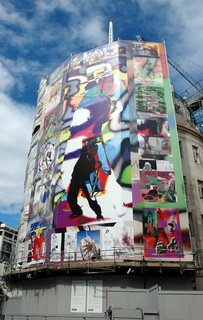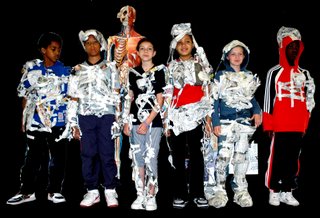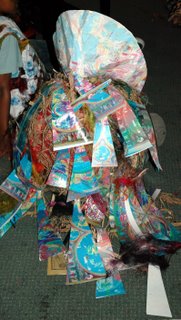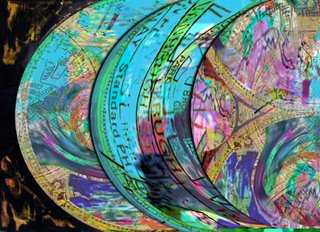Tuesday, November 07, 2006
Maps and Journeys Years 5-7
To develop individual/group responses to the theme based on personal ideas to create a fashion item, construction incorporating digital imagery leading to the design of a multimedia event for an invited audience. The Theme - Maps and Journeys
An an introductory activity the pupils worked in groups using newspaper and tape to create costumes based on the idea of body maps. This was followed by a brainstorming activity about ‘Maps and Journeys.’ Pupils were encouraged to consider their own journeys that might document a particular part of their life or a journey to school and how this could be represented in a visual way using maps of the local area with certain parts highlighted. Their ideas were further supplemented by a visit to Greenwich Maritime Museum where they had the opportunity to find out more about seafaring maps and the history of Greenwich as a trading port.
Developing Ideas
Pupils began to explore their initial ideas in their sketchbooks and developed them through a series of introductory workshops in textiles and ICT. They continued to research the theme through access to information on the internet and through their personal collections of information about themselves and their family histories and location recorded in their sketchbooks.
Textiles
The textile workshops introduced pupils to a range of textile processes including batik, weaving with found materials, layering using silk fibre and silk painting. Pupils were encouraged to be experimental with the materials and to bear in mind how they might use them as part of their costume.
ICT
Using Photoshop pupils layered images of contemporary and historical maps with some of their textile samples and made printouts on paper to be incorporated in to their textile pieces and constructions. Some of the images were printed on to transfer paper to be ironed on to fabric whilst others were cut, laminated and joined using string to make body panels. Throughout the course computers were used as a tool to develop ideas and to create layers of imagery and variations on a theme to enhance their individual ideas.
Outcomes
The Summer School gave the pupils the opportunity to work with artists and to engage in sustained activity. The use of ICT enabled them to develop creative ideas quickly to create personal response some working on the idea of body maps others on personal maps that combined images of themselves and family along with maps of their local area past and present. The ability to layer images within the software allowed the pupils to emphasise and transform elements of their designs in ways that would have been more difficult using traditional media The final presentation to an invited audience of parents, friends members of the Greenwich Gifted and Talented team consisted of a catwalk display of their costumes, a slideshow of digital images created throughout the project and a wall display of project work. The event was a celebration for all involved and a fitting end to two weeks exciting and challenging art activity.
Artists - Jenni Hughes, Debbie Brown, Kevin Mathieson
Monday, November 06, 2006
‘What’s in a Building’ Art and ICT Primary Year 5
Pupils from Colbourne Primary School in the West Midlands exploring the theme ‘Can Buildings Speak’ at the Black Country Museum in Dudley West Midlands . The project was co-ordinated by Park View City Learning Centre Alum Rock Birmingham using their mobile ICT suite on site at the museum.
On arrival at the Museum the pupils were given a guided tour of the site by two assistants in Victorian costume. The pupils used the opportunity to ask questions about the buildings they were interested in before choosing one to investigate more thoroughly.
They then proceeded to make drawings, rubbings and notes about their chosen building as well as recording particular architectural features using a digital camera.
During the lunch break the pupils digital photographs were downloaded on to the mobile suite of laptops that had been set up in one of the museums education rooms.
The afternoon session focused on developing a digital collage in Adobe Photoshop using elements from the digital photographs each pupil had taken. Each pupil was challenged to think about what they had experienced during the morning and to use parts of the digital photographs that represented their thoughts and feelings about the building they had investigated.
Completing the work
Two days later the pupils spent half a day at the Park View City Learning Centre in Alum Rock in Birmingham to complete their designs.
After reviewing the images they created on site at the museum the pupils used either a camera or scanner to digitise their sketches and rubbings made during the visit. They then incorporated elements of their drawings and rubbings in to the digital collages and used the layers option in Photoshop to merge the fragments together their images together.
Finally the pupils were asked to use text to incorporate some of their own thoughts or quotes they had recorded during the visit in to their designs.
On arrival at the Museum the pupils were given a guided tour of the site by two assistants in Victorian costume. The pupils used the opportunity to ask questions about the buildings they were interested in before choosing one to investigate more thoroughly.
They then proceeded to make drawings, rubbings and notes about their chosen building as well as recording particular architectural features using a digital camera.
During the lunch break the pupils digital photographs were downloaded on to the mobile suite of laptops that had been set up in one of the museums education rooms.
The afternoon session focused on developing a digital collage in Adobe Photoshop using elements from the digital photographs each pupil had taken. Each pupil was challenged to think about what they had experienced during the morning and to use parts of the digital photographs that represented their thoughts and feelings about the building they had investigated.
Completing the work
Two days later the pupils spent half a day at the Park View City Learning Centre in Alum Rock in Birmingham to complete their designs.
After reviewing the images they created on site at the museum the pupils used either a camera or scanner to digitise their sketches and rubbings made during the visit. They then incorporated elements of their drawings and rubbings in to the digital collages and used the layers option in Photoshop to merge the fragments together their images together.
Finally the pupils were asked to use text to incorporate some of their own thoughts or quotes they had recorded during the visit in to their designs.
BBC 21CC On Air

‘On Air’ was a BBC collaboration between All Souls Primary School, London and artists Tony Minnion of Cloth of Gold and Kevin Mathieson, Freelance Art & ICT Consultant.
Children in Year 5 (9-10 years) were asked to explore how broadcasting has changed since BBC Broadcasting House opened its doors in 1932, and to think about what broadcasting means to them now in their world and their times.
Pupils conjured up their reactions in a range of visual collages manipulated on a computer using Adobe PhotoShop Elements.
The result was an explosion of colour, shape and line - images of the building going through redevelopment and Eric Gill's famous statue of The Sower in the foyer of the building, combined with their own interpretation of the plethora of radio waves that now crisscross the airways and their physical responses and interpretation of it.
The finished children's collages were digitally combined by the artists into the one enormous integrated image which was then printed and hung on the outside of the BBC’s Broadcasting House in Central London in August and September 2004.
Measuring 22 meters high and 15 meters wide it is probably the largest pupil digital image ever made.
Thursday, November 02, 2006
ICT in Art and Design
This statement was developed to support the 'Embedding ICT in Art and Design Projec't funded by the DfES through BECTA, A4 - The Association for Advice and Support in Art and Design & NSEAD.
The appropriate use of new electronic media, by both teachers and learners, contributes significantly to art and design education and enriches learning. It provides a means for teachers to develop their professionalism, through documenting, assessing, researching and sharing their developments with other colleagues.
Many contemporary artists and designers now use ICT to develop and create their work. Computer technologies are challenging us to rethink the ways in which our skills, knowledge and understanding are applied in the creative production of works of art and design. This practice needs to be reflected in the classroom.
The Technological Challenge identified within All our Futures DfES 1999 (the National Advisory Committee for Creative and Cultural Education NACCCE), presents the most compelling evidence for the personal and educational needs of young people within a rapidly developing technological world and working environment. This evidence identifies a rapidly developing digital culture, and in particular a visual digital culture that pervades our life, through the worlds of education, entertainment, leisure and the workplace.
ICT provides access to an extraordinary range of new resources, and offers a powerful and dynamic means of visual communication and expression, potentially reaching new audiences and offering new opportunities for collaborative working. The need for sophisticated and well-developed visual literacy skills, along with understanding of the use of digital technology in the creative industries, in the context of education, entertainment, leisure and for the workplace, will provide many of the essential skills for all aspects of future life.
In particular, the use of ICT in Art and Design provides opportunities for learners to:
• access to works of art and trans-cultural artefacts, on a global scale, past and present, through visiting virtual galleries on the Internet;
• provide a new range of opportunities to develop their own ideas in an experimental way and take creative risks;
• discover their creative potential by engaging in different kinds of activities;
• review, refine and modify two and three-dimensional work in progress;
• work with others (peers/teachers/experts etc) to develop their ideas;
• share their ideas (and promote the school) with a wide audience of peers, colleagues, parents and prospective parents.
• develop work across subject areas
The ways in which we send and receive information are changing rapidly. Much of this information is visual and time-based. Learning to understand, manipulate and evaluate both the technologies involved and the content that is being created and distributed is becoming an increasingly essential skill.
Art and Design provides excellent opportunities for learners to develop skills in a wide range of software and communication technologies, e.g. DTP (Desktop Publishing), animation, digital photography, image manipulation, video, three-dimensional and web page design. As well as enhancing general investigation, problem-solving, critical thinking and communication capabilities, expertise in these new technologies helps prepare people to work in the creative industries.
Experience also shows that children and students (including those who find it difficult to access mainstream education) are strongly engaged and motivated by Art and Design work that involves the use of ICT. They often sustain an extended interest in response to alternative and challenging approaches inherent in the media, redrafting their ideas through processes that can integrate conventional and digital media. This can lead them back into more conventional art forms utilising ideas gained through these digital processes.
The Art and Design subject associations are therefore committed to supporting the development of ICT in Art and Design education in terms of its contribution to the subject and its value for all aspects of education, lifelong learning and its potential vocational content. It considers that these will be achieved through continuing consideration of curriculum content and examination requirements and in the sustained investment in professional development and classroom resources.
November 2004
The appropriate use of new electronic media, by both teachers and learners, contributes significantly to art and design education and enriches learning. It provides a means for teachers to develop their professionalism, through documenting, assessing, researching and sharing their developments with other colleagues.
Many contemporary artists and designers now use ICT to develop and create their work. Computer technologies are challenging us to rethink the ways in which our skills, knowledge and understanding are applied in the creative production of works of art and design. This practice needs to be reflected in the classroom.
The Technological Challenge identified within All our Futures DfES 1999 (the National Advisory Committee for Creative and Cultural Education NACCCE), presents the most compelling evidence for the personal and educational needs of young people within a rapidly developing technological world and working environment. This evidence identifies a rapidly developing digital culture, and in particular a visual digital culture that pervades our life, through the worlds of education, entertainment, leisure and the workplace.
ICT provides access to an extraordinary range of new resources, and offers a powerful and dynamic means of visual communication and expression, potentially reaching new audiences and offering new opportunities for collaborative working. The need for sophisticated and well-developed visual literacy skills, along with understanding of the use of digital technology in the creative industries, in the context of education, entertainment, leisure and for the workplace, will provide many of the essential skills for all aspects of future life.
In particular, the use of ICT in Art and Design provides opportunities for learners to:
• access to works of art and trans-cultural artefacts, on a global scale, past and present, through visiting virtual galleries on the Internet;
• provide a new range of opportunities to develop their own ideas in an experimental way and take creative risks;
• discover their creative potential by engaging in different kinds of activities;
• review, refine and modify two and three-dimensional work in progress;
• work with others (peers/teachers/experts etc) to develop their ideas;
• share their ideas (and promote the school) with a wide audience of peers, colleagues, parents and prospective parents.
• develop work across subject areas
The ways in which we send and receive information are changing rapidly. Much of this information is visual and time-based. Learning to understand, manipulate and evaluate both the technologies involved and the content that is being created and distributed is becoming an increasingly essential skill.
Art and Design provides excellent opportunities for learners to develop skills in a wide range of software and communication technologies, e.g. DTP (Desktop Publishing), animation, digital photography, image manipulation, video, three-dimensional and web page design. As well as enhancing general investigation, problem-solving, critical thinking and communication capabilities, expertise in these new technologies helps prepare people to work in the creative industries.
Experience also shows that children and students (including those who find it difficult to access mainstream education) are strongly engaged and motivated by Art and Design work that involves the use of ICT. They often sustain an extended interest in response to alternative and challenging approaches inherent in the media, redrafting their ideas through processes that can integrate conventional and digital media. This can lead them back into more conventional art forms utilising ideas gained through these digital processes.
The Art and Design subject associations are therefore committed to supporting the development of ICT in Art and Design education in terms of its contribution to the subject and its value for all aspects of education, lifelong learning and its potential vocational content. It considers that these will be achieved through continuing consideration of curriculum content and examination requirements and in the sustained investment in professional development and classroom resources.
November 2004
Subscribe to:
Posts (Atom)


